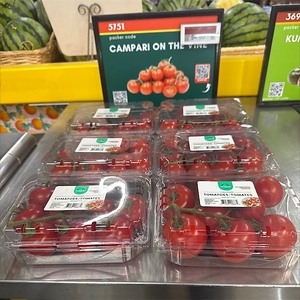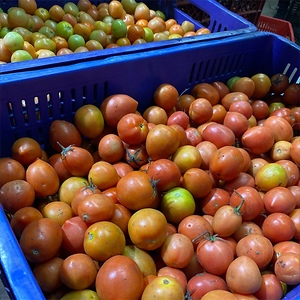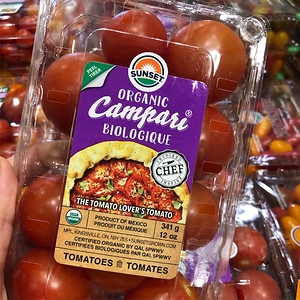


Campari Tomatoes
Estimated Inventory, 16 ct : 0
Description/Taste
Campari tomatoes are a small to medium-sized variety, averaging 5 to 7 centimeters in diameter, and have a round to oblate shape with a uniform, curved nature. The variety is frequently sold still attached to the vine and is capped with slender, pointed leaves. The tomato’s skin is thin, smooth, taut, and glossy with a firm feel. The variety ripens to bright red, saturated shades. Underneath the surface, the red flesh is soft, tender, and aqueous, encasing several chambers filled with tiny yellow seeds suspended in gelatinous liquid. Campari tomatoes are known for having a crisp, popping sensation when bitten, giving way to the soft, juicy interior. The variety is edible raw once ripe and releases a savory, green, and subtly earthy aroma if sold on the vine. The flesh has balanced sugar and acidity levels, creating a rich, sweet, and savory flavor.
Seasons/Availability
Campari tomatoes are available year-round.
Current Facts
Campari tomatoes, botanically classified as Solanum lycopersicum, are a Dutch variety belonging to the Solanaceae or nightshade family. The hybrid tomato was developed in the late 20th century and is a type of cocktail tomato. Campari tomatoes are famous for their darker coloring, balanced sweetness and acidity, and rounded nature. The variety is traditionally grown using hydroponic methods and is often sold still attached to the vine to indicate freshness. Campari tomatoes are considered to be one of the first branded tomato varieties. They were given an Italian-rooted name as a tribute and symbol of friendship to Italy and the Italian liqueur of the same name, which was allegedly inspired by Dutch liqueurs. Campari tomatoes were also branded with the slogan The Tomato Lover’s Tomato® to distinguish the variety from other tomatoes in markets. In the modern day, Campari tomatoes are a commercially popular cocktail tomato in Europe and North America and are sought by chefs and home cooks for their rich flavoring and versatility in fresh and cooked culinary preparations.
Nutritional Value
Campari tomatoes are a source of vitamins A, C, E, and K to maintain healthy organs, strengthen the immune system, guard cells against free radical damage, and aid in faster wound healing. Tomatoes also provide lycopene, a natural pigment with antioxidant properties that reduce inflammation and contribute to overall bodily health. Beyond vitamins, Campari tomatoes contain fiber to regulate the digestive tract, calcium and phosphorus to support bones and teeth, and potassium to balance fluid levels within the body. Tomatoes also provide magnesium to control nerve functions, copper to produce red blood cells, and other nutrients, like iron, manganese, and zinc.
Applications
Campari tomatoes have a balanced, sweet, savory, and acidic taste suited for fresh and cooked preparations. The variety’s size allows it to be eaten out of hand as a snack or halved and tossed into salads and grain bowls. Campari tomatoes are popularly diced into condiments like salsa and hummus or chopped and served with herbs as an edible garnish. They are also diced for bruschetta, sliced and served with meats and cheeses, or layered into sandwiches. The variety is favored for its rich, sweet flavor and can be used in any preparation calling for raw tomatoes. In addition to fresh recipes, Campari tomatoes are simmered into sauces, jams, and chutneys. They are also roasted with garlic as a flavoring in main dishes, tossed into pasta, or sliced and cooked into tarts and pies. Try blending Campari tomatoes into soups, curries, and stews for added complexity. The variety can also be baked into biscuits, slow-cooked with meats like brisket, or used as a base for homemade pizzas. Campari tomatoes pair well with herbs such as oregano, basil, and thyme, aromatics like garlic, onions, and shallots, broccoli, eggplant, carrots, and potatoes. Whole, unwashed Campari tomatoes will keep for several days when stored in a cool, dry, and dark place.
Ethnic/Cultural Info
Campari tomatoes arrived in commercial markets during a tumultuous time between Dutch growers and German retailers in the late 20th century. In the 1990s, Dutch tomatoes were being portrayed in a negative light through German media outlets. Much of the tomato’s unwanted press was centered around the lack of flavor. Despite Germany and the Netherlands growing many of the same tomato varieties during this time, German consumers began to be swayed by these messages, becoming influenced to avoid Dutch-grown tomatoes. In 1995, a famous televised discussion between Dutch grower Ton Janssen and a German chef also marked a turning point, when the chef called Dutch tomatoes wasserbombe, meaning “water bombs.” After the broadcast, Ton Janssen began searching for a new flavor-centric tomato variety in the Netherlands and evaluated over twenty types from seed breeding companies. Janssen eventually encountered Campari tomatoes by the Dutch breeding company Enza Zaden and obtained exclusive cultivation rights to grow the variety for Northwestern Europe. Janssen partnered with two other Dutch growers, Hans Gerald and Eric Vereijken, to form Frutanova, a Dutch producer association promoting Campari tomatoes under the brand name Tasty Tom. The three growers began advertising the new tomato brand through word of mouth, and Janssen has mentioned in interviews that he visited all of the main wholesale markets in Germany to provide samples to retailers. Tasty Tom tomatoes quickly increased in notoriety and popularity as word spread throughout Germany, and the cocktail tomato helped reform and establish Dutch tomatoes as a mark of quality in both German and Dutch markets.
Geography/History
Campari tomatoes are native to the Netherlands and were developed by the Dutch breeding company Enza Zaden in the city of Enkhuizen in North Holland. According to history mentioned on Enza Zaden’s website, Campari tomatoes were bred in the 1980s and were an experiment that resulted in flavorful tomatoes that did not fit within a clear category at the time. Later in the 1990s, the variety was noticed by Dutch and Canadian growers and was added to the Netherlands Register of Plant Varieties in 1995. Campari tomatoes are hydroponically grown and are said to be a natural hybrid that has not been genetically modified. Beginning in the mid to late 1990s, the variety was grown and marketed through Frutanova U.A., a Dutch growers' association, in Europe and through the Mastronardi Produce Company based in Ontario, Canada, throughout North America. The Mastronardi family of the Canadian produce company became inspired by Dutch growers on a trip to the Netherlands in the early 1940s and was one of the first companies in Canada to utilize greenhouse cultivation. After several trips to the Netherlands years later, they also discovered Campari tomatoes and began growing and selling them throughout Canada and the United States. Today, Campari tomatoes are prevalent throughout North America and Europe and are cultivated in greenhouses and occasionally in outdoor fields. The specialty variety is sold through retailers, wholesalers, and supermarkets.
Recipe Ideas
Recipes that include Campari Tomatoes. One
Podcast

















